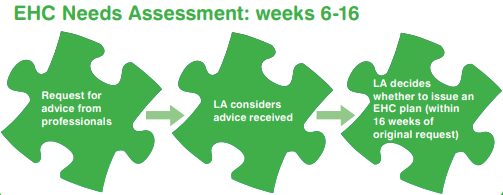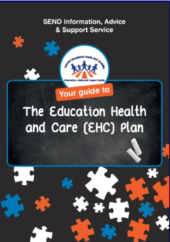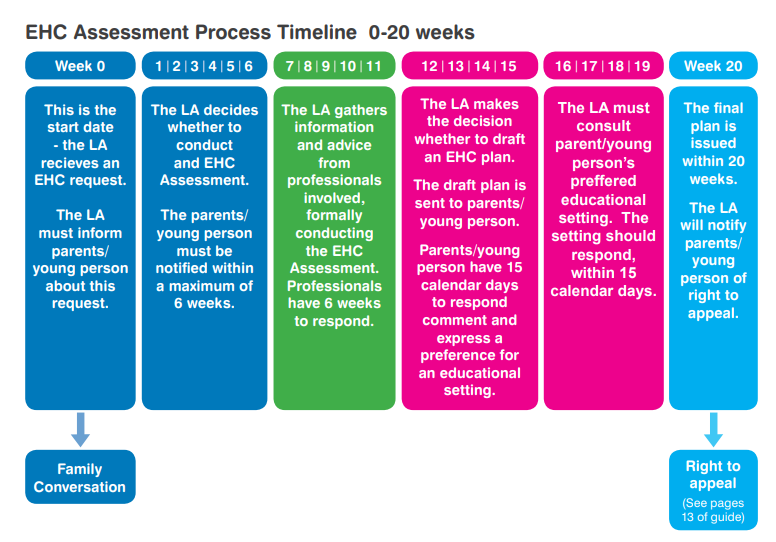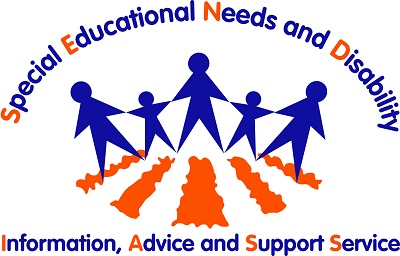Special Educational Needs (SEN) support
This page includes information on:
- What is SEND? [#What is SEND?]
- How do education settings give help to children with Special Educational Needs - SEN Support [#How do education settings give help to children with Special Educational Needs -Â SEN Support]
- What does SEN Support look like - Assess, Plan, Do, Review? [#What does SEN Support look like?]
- How can the educational setting support my child? [#How can the educational setting support my child?]
- What if my child’s needs cannot be met with SEN Support? [#What if my childâs needs cannot be met with SEN Support?]
What is SEND?
A child or young person has SEND if they have a learning difficulty or disability which calls for special educational provision to be made for him or her. Special educational provision for a child over 2 years old, is defined as:
"Educational or training provision which is additional to or different from that made generally for other children of the same age by mainstream schools, maintained nursery schools, mainstream post-16 institutions or by relevant early years providers"
Children and young people with SEN may need extra help because of a range of needs. These needs fall within four broad areas:
Cognition and Learning
- Specific areas of learning like reading, writing and number work
- Memory difficulties
- Learning at a slower pace
- The gap between your child and their peers widening
Communication and Interaction
- Difficulties with understanding what others are saying
- Difficulties expressing themselves
- Speech & Language difficulties
- Difficulties with social interaction (particularly for those with ASD)
Social, emotional and mental health difficulties
- Problems managing emotions and/or behaviour
- Difficulty making friends and relating to other people
- Mental health such as anxiety and depression
Sensory and/or physical needs
- Problems with sight or hearing
- Problems moving around
- Medical problems that have an impact on learning
Medical Needs
Those children and young people with medical needs may not require special educational provision to meet their needs. However, schools have a duty to make such arrangements. This is normally through an Individual healthcare plan – there is statutory guidance available (Supporting pupils at school with medical conditions [https://www.gov.uk/government/publications/supporting-pupils-at-school-with-medical-conditions--3]). It is important to remember that:
- Not all children with a disability and/or medical needs have SEN
- Not all children with SEN have a diagnosis
Disability
Whilst there is often an overlap, having a disability does not necessarily mean a child/young person has SEN.
However, there are legal obligations on educational settings to provide for disabled pupils to ensure they are not substantially disadvantaged. This includes making reasonable adjustments and publishing accessibility plans.
How do education settings give help to children with Special Educational Needs - SEN Support
Mainstream early years settings, schools, and post-16 settings have a duty to identify and support children and young people with Special Educational Needs and Disabilities (SEND).
"Early years providers, schools and colleges should know precisely where children and young people with SEN are in their learning and development and are having the required impact on progress (paragraph 1.25)" SEN Code of Practice.
Unless stated, “educational settings” relates to: maintained nursery schools, mainstream schools including academies and free schools, 16-19 academies, alternative provision academies, pupil referral units, school sixth forms, sixth form colleges, and further education colleges.
They should:
- Ensure decisions are informed by the insights of parents and those of children and young people themselves
- Have high ambitions and set stretching targets for them
- Track their progress towards these goals
- Keep under review the additional or different provision that is made for them
- Promote positive outcomes in the wider areas of personal and social development, and ensure that the approaches used are based on the best possible evidence
There are three important chapters of the SEND Code of Practice 2015 that sets out this process in full:
Chapter 5 focuses on the actions that early years providers should take to meet their duties around identifying and supporting SEN in their settings.
Chapter 6 focuses on the actions that mainstream schools should take to meet their duties around identifying and supporting SEN in their settings.
Chapter 7 focuses on further education - including FE colleges, sixth form colleges 16-19 academies and some independent specialist colleges.
The SEND Code of Practice is available to download at www.gov.uk/government/publications/send-code-ofpractice-0-to-25 [http://www.gov.uk/government/publications/send-code-ofpractice-0-to-25]
There is also a Special Educational Needs and Disability Guide for Parent/Carers Code of Practice [https://www.gov.uk/government/uploads/system/uploads/attachment_data/file/344424/Special_educational_needs_and_disabilites_guide_for_parents_and_carers.pdf] available for you to download.
What does SEN Support look like - Assess, Plan, Do, Review?
If your child has been identified as having SEN, the Code of Practice is very clear that parents (and the child/young person where appropriate) must be informed and their views listened to.
The educational setting should follow a four-part cycle which is called “the graduated approach”. These four parts are called “Assess”, “Plan”, “Do”, “Review”.
Assess
In identifying a child as needing SEN support, a teacher or keyworker, working with the Special Educational Needs Co-Ordinator, should carry out a clear analysis of the pupil’s needs with input from parents and the views of your child/young person.
In some cases, outside professionals from health or social services may already be involved with the child/young person. These professionals should liaise with the setting to help inform the assessments. If necessary, where professionals are not already working with the child/young person the SENCO should contact them if the parents agree.
The information gathered in assessment should be available to, and discussed with, the pupil/parents, normally as a written record. This may be known as an “IEP”, “Pupil pathway”, or “My Support Plan”.
A written record can then be used to review support for the young person, especially during transition from one setting to another (e.g. nursery to school, primary school to secondary school, school to college).
Plan
The setting, in consultation with the parent and the pupil, should agree:
• The adjustments, interventions and support to be put in place
• The expected impact on progress, development or behaviour
• A clear date for review
All staff working with the pupil should be made aware of their needs, the outcomes sought, the support provided and any teaching strategies or approaches that are required. The type of support and intervention provided should be selected to meet the outcomes identified for the pupil, based on reliable evidence.
The information gathered in the assessment should be available to and discussed with the pupil/parents, normally as a written record e.g. IEP, Pupil pathway, My Support Plan.
Do
The teacher or keyworker is responsible for working with the pupil on a daily basis. Where interventions involve group or one-to-one teaching away from them, they still retain responsibility for the pupil.
They should work closely with any teaching assistants or specialist staff involved, to plan and assess the impact of support and interventions and how they can be linked to classroom teaching. The SENCO should support the class or subject teacher in the further assessment of the child’s strengths and weaknesses, in problem-solving and advising on the effective implementation of support.
Review
The effectiveness of the support, interventions and their impact on the pupil’s progress should be reviewed in line with agreed dates. This should normally be three times per year.
The pupil and their parents should have clear information about the interventions provided and the impact of the support (a written record is advisable). This enables them to be involved in planning the next cycle.
How can the educational setting support my child?
All pre-school settings, schools and post 16 settings must have a clear path to identifying and responding to SEN. For schools, this must be published in their “SEN Information Report”, available on the school’s website.
As well as high-quality teaching and adapting work to suit, children and young people with SEN may need extra help. This may involve the use of specialists to support the setting, either to help identify SEN or suggest effective interventions.
The types of specialist that may be involved include:
- Educational Psychologists (EP)
- Child and Adolescent Mental Health Services (CAMHS)
- Specialist Teachers, in areas like early years, ASD, hearing and vision impairment, emotional well-being.
- Therapists - speech and language (S<), physiotherapy, occupational therapy (OT)
Referrals to these types of specialists cannot normally be made directly by a child/young person or their parent – discuss this with your educational setting or GP.
Who do I speak to in my child’s setting?
All early years settings and schools must have a Special Educational Needs Co-ordinator (SENCO) who arranges and co-ordinates provision for children with SEN. The SENCO will work closely with other staff, parents and external support services.
Colleges usually have a named person who is responsible for making sure that young people with SEN have support and provision in place to help them.
How is SEN Support funded?
Educational settings (not including early years providers which are not maintained nursery schools) receive an allocation of funding often referred to as “element 2 funding”, “SEN notional budget” or “disadvantage funding”. This is used by settings to provide SEN provision which is “additional to and different from” and is used to meet the first £6,000 of additional support for an individual.
This does not mean that the school will spend £6,000 on every child with SEN. Sometimes schools use funds to help groups of children. Some children will need less help – and some children may need more.
What if my child’s needs cannot be met with SEN Support?
The majority of children and young people with special educational needs will have their needs met at ‘SEN Support’ within a mainstream setting. Some children and young people, however may still struggle and the setting will talk to you about making a request for an Education, Health and Care (EHC) Needs Assessment.
An EHC needs assessment (EHCNA) is an in-depth assessment of a child or young person’s special educational needs (SEN) and brings together information about:
- What your child or young person can or cannot do
- The special help and support he or she needs to learn and progress
The Local Authority (Coventry City Council) is responsible for carrying out EHCNA in Coventry under the Children and Families Act 2014.
For more information, see our pages on EHC needs assessments [https://www.covsendiass.co.uk/advice-support/education/3] and downloadable guide “Your guide to EHC Needs Assessments” [https://www.covsendiass.co.uk/downloads/download/13/education-health-and-care-ehc-needs-assessment-and-plans].
Other information sources you may find useful:
- ACE [http://www.ace-ed.org.uk/advice-about-education-for-parents] - information is based on current education law and guidance and covers state funded education for children aged 5-16 years in England only
- DfE Guidance Mental Health and Behaviour in Schools [https://www.gov.uk/government/uploads/system/uploads/attachment_data/file/326551/Mental_Health_and_Behaviour_-_Information_and_Tools_for_Schools_final_website__2__25-06-14.pdf] and Supporting pupils at school with medical conditions [https://www.gov.uk/government/publications/supporting-pupils-at-school-with-medical-conditions--3]
- IPSEA [https://www.ipsea.org.uk/] - trained volunteers give free, legally based independent advice and support in England and Wales to help get the right education for children with SEN/D.
- Child Law Advice [https://childlawadvice.org.uk/] provides free legal information, advice and representation to children, young people, their families, carers and professionals, as well as international consultancy on child law and children's rights.
- The Coventry Special Educational Needs and Disability (SEND) Local Offer [https://www.coventry.gov.uk/sendlocaloffer] brings together information for children and young people with special educational needs and disabilities and their families. The SEND Local Offer will cover services available to the public across education, health and social care:
- Education: such as nurseries, playgroups, schools and colleges and support services like educational psychologists and SEN services
- Health: children's and adult services including GPs, therapists and hospital services.
- Social care: such as short break services and children's and adult disability services.
- Council for Disabled Children [https://councilfordisabledchildren.org.uk/] - The umbrella body for the disabled children's sector bringing together professionals, practitioners and policy-makers.
My Support Plan
What is My Support Plan?
My Support Plan is a document that can be used to clearly identify the hopes and aspirations, Special Educational Needs (SEN), and provision needed to ensure your child/young person achieves the best possible outcomes in their education setting.
It is designed for youngsters who have been identified with Special Educational Needs - meaning that they receive provision which is different from or additional to that is normally available to pupils of the same age due to their learning difficulty or disability. To support these SEN may need input from a range of professionals outside of those working in their current educational setting.
When should I get a My Support Plan?
Whatever stage of their educational journey - in the early years, school or in further education - children and young people with SEND should have any needs identified and regularly monitored. This is normally done by the setting, with either a class teacher or SENCo taking the lead, with input from the child/ young person and their parents/carers.
It is expected that this input is evidenced through a form of paperwork - this might be something developed by the individual setting, like an Individual Education Plan (IEP), student support plan or other equivalent. It could also use a My Support Plan.
However, it is expected that settings will use My Support Plan for those children and young people where there is a need to combine and co-ordinate support from several different professionals or agencies. This might mean the child/ young person has support from:
- An Educational Psychologist
- A specialist teacher
- A health professional, such as Speech & Language Therapist, physiotherapist, Occupational Therapist, or CAMHS worker
- A social worker or Early support/Family Hub worker
Where appropriate, these professionals would be expected to be involved in contributing to the My Support Plan.
The My Support Plan might also be appropriate when:
- A child/young person is transitioning between two settings e.g. from nursery into school; school into college.
- When a child/young person’s learning needs have not responded to the setting and single agency intervention.
- The setting is considering requesting an Education Health and Care Needs Assessment (EHCNA) for a child/young person.
What part should the child/young person and a parent/carer have in a My Support Plan?
In line with the basic principles outlined in the Children and Families Act 2014, participation of all parties involved in decision making about a child/young person, including the child young person and their parents/carers, should be at the centre of any discussions.
The setting should aim to collect the views of the child and parent before the first My Support Plan meeting, with the meeting itself bringing them together with teachers, key workers and professionals to identify the needs and provision required.
Following the drafting of the My Support Plan, children/young people and their parents should be able to see it and suggest any changes before it is used.
Once it is agreed, the plan should be reviewed on a regular basis. It is expected that this would be on a termly basis, to fit in with the expectation that progress is reviewed on a regular basis, and at least three times per year. (See 5.43 - 5.47 for Early Years; 6.64 - 6.71 for School; & 7.19 - 7.21 for Further Education of the SEND Code of Practice)
What’s the difference between a My Support Plan and an EHC Plan?
This can be a bit confusing given they are both called “plans” and the documents used look very similar - however there are some important differences to be aware of.
An Education Health and Care Plan (EHCP):
- is a statutory document which is created following a specified assessment co-ordinated by Coventry’s Statutory Assessment and Review Team (START).
- specifies special educational provision in section F and this must be provided.
- can be appealed through the SEND First-tier Tribunal if a parent or young person wants to change certain elements within the plan.
A My Support Plan:
- is co-ordinated by the educational setting and has no legal status.
- does not have a requirement to involve a particular professional or agency in assessment or provision.
- cannot be appealed to the SEND Tribunal.
For further information about the My Support Plan, please contact the SENCo at your child/young person’s educational setting. There is also further information available on Coventry’s Local Offer [https://www.coventry.gov.uk/sendlocaloffer].
What parents have said about My Support Plan
"Our hopes and aspirations were gathered by sitting together as a team. Everybody was involved, even my son, and his piece is in the plan for everyone to have a look at and know what he wants."
"I was there when the paperwork was done and everyone had their say. I could say it as it was and it was then phrased in the correct way. It’s thorough, so you can’t miss anything out!"
"We all worked together! It was very straight forward and if anyone didn’t agree it was discussed and an outcome came from it."
Education Health and Care (EHC) Needs Assessment
This page covers:
- What is an EHC Needs Assessment/When is an EHC needs assessment necessary? [#What is an EHC Needs Assessment]
- Making an EHC Needs Assessment Request [#Making an EHC Needs Assessment Request]
- What happens if the local authority decides that an EHC Needs Assessment is not necessary? [#What happens if the local authority decides that an EHC Needs Assessment is not necessary?]
- What happens if the EHC Needs Assessment goes ahead? [#What happens if the EHC Needs Assessment goes ahead?]
- EHC Needs Assessment: What happens next? [#EHC Needs Assessment: What happens next?]
- What if I do not agree with the Local Authority about the EHC Needs Assessment? [#What if I do not agree with the Local Authority about the EHC Needs Assessment?]
What is an EHC Needs Assessment
The EHC Needs Assessment is sometimes called ‘Statutory Assessment’ and concerns:
- Children in early years settings, for example nurseries
- Children of school age
- Young people (up to 25yrs) in Post-16 provision, for example colleges
An EHC needs assessment is an in depth assessment of a child or young person’s special educational needs (SEN) and the help and support he or she needs to learn and make progress. The Local Authority (Coventry City Council) is responsible for carrying out EHC needs assessments in Coventry under the Children and Families Act 2014 and Chapter 9 of the SEND Code of Practice 2015 sets out this process in full. It is available to download at www.gov.uk/government/publications/send-code-of-practice-0-to-25 [http://www.gov.uk/government/publications/send-code-of-practice-0-to-25]
The needs assessment is a detailed look at your child or young person’s difficulties and brings together information about:
- What your child or young person can or cannot do
- The special help and support he or she needs
The assessment will include information from:
- Parents/carers
- The child or young person
- The nursery, school or college your child attends
- Other professionals who work with and support your child
The assessment will determine if your child or young person needs an Education, Health and Care Plan (EHC plan).
When is an EHC needs assessment necessary?
The majority of children and young people with special educational needs will have their needs met at ‘SEN Support’ within a mainstream setting. This means that the nursery, school or college makes additional or different provision to meet their needs. This may include the involvement of other professionals and specialist support services, such as an Educational Psychologist or Sensory Support (see our guide on SEN Support for further information).
The SEND Code of Practice says:
In considering whether an EHC assessment is necessary, the local authority should consider whether there is evidence that despite the early years provider, school or post 16 institution having taken relevant and purposeful action to identify, assess and meet the special educational needs of the child or young person, the child or young person has not made expected progress (9.14).
Making an EHC Needs Assessment Request
The Local Authority has a duty to consider requests for an EHC needs assessment. In the majority of cases, the requests are made by the educational setting together with parents/carers and the young person, but requests can also be made by:
- Parents (for children under 16)
- Young people (between the ages of 16 and 25)
The SEND Code of Practice says:
The Local Authority must conduct an assessment of education, health and care needs when it considers that it may be necessary for special educational provision to be made for the child or young person in accordance with an EHC plan (9.3).
When considering a request for an EHC assessment the Local Authority will look at:
- The child or young person’s level of attainment and rate of progress
- The child or young person’s special educational needs
- The support that is in place and what has already been done to help
- The difference that the extra support has made
- The child or young person’s physical, emotional and social development and health needs
- Where the young person is over 18 whether he or she needs additional time to complete education or training
Coventry Local Authority has developed criteria as a guideline to help them decide when it is necessary to carry out an EHC assessment. You can find this criteria at: www.coventry.gov.uk/sendcriteria [http://www.coventry.gov.uk/sendcriteria]
The SEND Code of Practice says:
In considering whether an EHC needs assessment is necessary, local authorities should pay particular attention to the views, wishes and feelings of the child and his or her parent, or the young person (9.12).
The “Family conversation” is a tool used to gain the views of parents and carers as part of the EHC needs assessment process. It normally takes place prior to a request being made, normally alongside the educational setting. The information gathered during the family conversation should then be used across agencies so families need only tell their story once.
Once the local authority receives an EHC assessment request it has 6 weeks to notify parents, school and everyone involved of its decision.
Timeline: EHC Needs Assessment: weeks 0-6
- Request is made (by school, parent or young person)
- Notification of receipt by Local Authority
- Decision made within 6 weeks

The local authority’s decision
What happens if the local authority decides that an EHC Needs Assessment is not necessary?
The local authority must tell you why it thinks that an EHC needs assessment is not needed. It must also tell you about:
- Your right of appeal
- Independent disagreement resolution and mediation
- How to get further advice and support
If you disagree with the local authority’s decision you can contact the EHC Plan Co-ordinator who will be named on the decision letter and/or the SEND Information, Advice and Support Service which will be able to discuss your options with you.
The SEND Code of Practice says:
“The Local Authority should also provide feedback collected during the process of considering whether an EHC needs assessment is necessary, including evidence from professionals, which the parent, young person, early years provider, school and post 16 institution may find useful” (9.19).
What happens if the EHC Needs Assessment goes ahead?
Once a decision to move ahead with the assessment is made, the local authority will ask for advice from relevant professionals about your child or young person’s education, health and care needs.
The local authority must ask for advice and information from:
- Parents/carers or the young person
- Your child or young person’s early years setting, school or college - If your child has a vision or hearing impairment, the local authority must also seek information and advice from a suitably qualified teacher
- Educational Psychologist
- Health professionals who work with your child or young person. This might include a pediatrician, speech and language therapist, physiotherapist or occupational therapist
- Social care
- Anyone else you ask them to contact who may be able to give relevant advice
Timeline: EHC Needs Assessment weeks 6-16
- Request for advice from professionals
- LA considers advice received
- LA decides whether to issue an EHC plan (within 16 weeks of original request)

EHC Needs Assessment: What happens next?
The local authority will carefully consider all of the advice collected during the assessment and will decide whether an EHC Plan is necessary for your child or young person.
If the LA decides not to issue an EHC plan
If following the completion of an EHC needs assessment the local authority decides NOT to issue an EHC Plan it must notify you, the current educational setting and services involved and give reasons for the decision. This notification must take place as soon as practicable and at the latest within 16 weeks of the initial request.
If the local authority decides not to issue a draft EHC Plan it must tell you about:
- Your right of appeal
- Independent disagreement resolution and mediation
- How to get further advice and support
Again, if you disagree with the local authority’s decision you can contact the EHC Plan Co-ordinator who will be named on the decision letter and/or the SEND Information, Advice and Support Service which will be able to discuss your options with you.
If the LA does decide to issue an EHC Plan
If the local authority decides that an EHC Plan is necessary, they will send you a draft EHC Plan, together with a copy of all the advice and reports collected during the assessment.
The EHC Plan is a legal document written by an EHC Plan Co-ordinator of the Local Authority. It describes the special educational needs that your child or young person has and the provision needed for them to meet those needs and achieve outcomes.
The EHC Plan will also include any health and care provision which is needed. You can read more about Education, Health and Care Plans in our next guide ‘Your guide to the EHC Plan.’
EHC Needs Assessment: weeks 16-20
- Draft plan sent to parents/young people
- Parents/young people have 15 days to give views and request an educational setting
- Final EHC plan issued (within 20 weeks of initial request).

How long does the whole assessment process take?
The whole process should take no more than 20 weeks. View the 'EHC Assessment Process Timeline' below for a breakdown of what happens and when.
Timelines in Full
What if I do not agree with the Local Authority about the EHC Needs Assessment?
At any stage of the process you can talk to your Local Authority EHC Plan Co-ordinator. This person will be named in the letter you receive from the Local Authority to notify you that it has received a request for an EHC assessment.
The SEND Information, Advice and Support Service (SENDIASS) can give you impartial, confidential information and advice about the options open to you, discuss any concerns you may have and support you through the process.
The Local Authority must inform you of your right to appeal to the Special Educational Needs and Disability Tribunal Service (SENDIST) and the requirement for you to consider mediation should you wish to appeal.
The Local Authority will state this in its letter to you at the following stages:
1. If the Local Authority refuse to make an EHC assessment of your child or young person’s special educational needs
2. If the Local Authority refuse to issue a draft EHC Plan following the assessment
You can find out more information about resolving disagreements in Chapter 11 of the Code of Practice. www.gov.uk/government/publications/send-code-of-practice-0-to-25 [http://www.gov.uk/government/publications/send-code-of-practice-0-to-25] or in our sections on Resolving Disagr [https://www.covsendiass.co.uk/advice-support/resolving-disagreements]eements [https://www.covsendiass.co.uk/advice-support/resolving-disagreements].
Other sources of EHC information
- IPSEA have produced an EHC plan checklist [https://www.ipsea.org.uk/Handlers/Download.ashx?IDMF=afd8d11f-5f75-44e0-8f90-e2e7385e55f0] that sets out what legally must be included as a minimum in any EHC plan issued by a Local Authority.
- You may find the Special Educational Needs and Disability Code of Practice : A Guide for Parents and Carers [https://www.gov.uk/government/uploads/system/uploads/attachment_data/file/344424/Special_educational_needs_and_disabilites_guide_for_parents_and_carers.pdf] a useful source of information. Chapter 9 focusses on the Education Health and Care Needs Assessments and Plans.
Personal Budgets
You are entitled to request a Personal Budget if your child has an EHC plan or has been assessed as needing a plan. A Personal Budget is an amount of money your Local Authority has identified to meet some of the needs in your child's EHC plan, if you want to be involved in choosing and arranging a part of the provision to meet your child's needs. You (or your representative) will need to agree this with your Local Authority. A Personal Budget can only be used for agreed provision in the EHC plan.
The Special Educational Needs Jungle also provides information on Personal Budgets [http://www.specialneedsjungle.com/personal-budgets-good-bad-ugly/] which you may find useful.
Transport
The Department for Education has produced Home to School Travel and Transport Guidance [https://www.gov.uk/government/uploads/system/uploads/attachment_data/file/331654/Home_to_school_travel_and_transport_statutory_guidance.pdf]. This guidance will help parents/schools/professionals understand the Local Authorities duty to have regard to the policy when carrying out their duties in relation to home to school travel and transport, and sustainable travel.
Coventry Local Authority's transport policy must be published as part of its Local Offer [https://www.coventry.gov.uk/sendlocaloffer].
There is a separate document for post-16 transport to education and training.
Education Health and Care Plans (EHC Plans)

This page contains information on:
- What is an EHC plan? [#What is an EHCÂ plan?]
- What must an EHCP include and how will I be involved? [#What must an EHC Plan include and how will I be involved?]
- The sections of an EHCP (Sections A-K) [#The Sections of an EHCP]
- The Golden Thread [#The Golden Thread]
- The Final EHC Plan [#The Final EHC Plan]
What is an EHC plan?
The SEND Code of Practice says:
“The purpose of an EHC Plan is to make special educational provision
to meet the special educational needs of the child or young person,
to secure the best possible outcomes for them across education,
health and social care and, as they get older, prepare them for adulthood” (9.2).
The majority of children and young people with SEN will have their needs met at ‘SEN Support’ within a mainstream educational setting. EHC Plans are for those children and young people whose needs cannot be met by the support that is usually available at their early years setting, school or college. After an EHC needs assessment has been completed and if the Local Authority decides that an EHC Plan is necessary, they will send you a draft EHC Plan, together with a copy of all of the advice and reports collected during the assessment.
The Local Authority must give you at least 15 days to respond and give your views on the content of the draft EHC Plan. During this period, the Local Authority must also make its officers available to meet with you or the young person if you wish to discuss any concerns and give your views on the plan’s content.
At this time you will also have the opportunity to state your preference for an educational setting. You also have the right to request a personal budget. All young people (those over 16 years old) with an EHC Plan, and all parents of children with an EHC plan can also ask for a Personal Budget.
What must an EHC Plan include and how will I be involved?
The SEND Code of Practice says:
“Decisions about the content of EHC Plans should be made openly and collaboratively with parents, children and young people. It should be clear how the child or young person has contributed to the plan and how their views are reflected in it.
EHC Plans should be clear, concise, understandable and accessible to parents, children and young people, providers and practitioners. They should be written so they can be understood by professionals in any Local Authority” (9.61)
The EHC Plan is split into sections A – K. We have broken down each section to help you understand what must be included (in line with the SEND Code of Practice), along with examples and “top tips” of what you should find within them.
The Sections of an EHCP
Section A: The views, interests and aspirations of the child and their parents, or of the young person
Wh at does the Code of Practice say should be included?
at does the Code of Practice say should be included?
- A brief history of the child/young person
- What the young person and their parents/carers want for the future (short term and long term)
- Details about play, health, schooling, independence, friendships
- How the child/young person communicates
Top Tips: 
- The information here should be reflected in the rest of the plan i.e. outcomes (section E) and provision (section F, G and H)
- We all have aspirations – and they often change. No-one should be limited to what they would ideally like to achieve, whether a type of job, where they’d like to live or how they participate in the community
Section B: The child or young person’s special educational needs (SEN)
A special educational need is a learning difficulty or disability which requires special educational provision.

What does the Code of Practice say should be included?
All the child/young person’s identified Special Educational Needs must be specified.
SEN may include needs for health and social care provision that are treated as special educational provision because they educate or train the child/young person (9.73)
Top Tips:
- Are the child/young person’s needs clear and easy to identify?
- Should include current levels of attainment inc. self-help skills, independence
- Is there a clear link between each need and the provision in Section F?
- ‘Content should be drawn from professional advice attached in Section K
Section C: The child or young person’s health needs which relate to their SEN
What does the Code of Practice say should be included?
The EHC plan must specify any health needs identified through the EHC needs assessment which relate to the child or young person’s SEN. Some health care needs, such as routine dental health needs, are unlikely to be related.
Top Tips:
- If there are health needs mentioned anywhere in the plan, they should be noted here e.g. sleep disorders, continence, gross motor skills
- Might their learning difficulty/disability be a barrier to health services like doctor/dentist appointments?
- A diagnosis is not a need
Section D: The child or young person’s social care needs which relate to their SEN or to a Disability

What does the Code of Practice say should be included?
- The EHC plan must specify any social care needs identified through the EHC needs assessment which relate to the child or young person’s SEN or which require provision for a child or young person under 18 under section 2 of the Chronically Sick and Disabled Persons Act 1970.
- With consent of child and parents, information about other care needs, such as Child Protection or Child in Need plan, to enable greater co-ordination of services
Top Tips:
What assessments during the EHC needs assessment were carried out to identify these needs? This will be noted in Section K. If there has been involvement from Early Help or social care, needs relating to SEN or a disability should be clearly identified in their assessments.
Section E: The outcomes sought for the child or the young person
These should be SMART: specific, measurable, achievable, realistic and time-bound.

What does the Code of Practice say should be included?
(See 9.64 for full description)
- EHC plans should be focused on education and training, health and care outcomes that will enable children and young people to progress in their learning and, as they get older, to be well prepared for adulthood. EHC plans can also include wider outcomes such as positive social relationships and emotional resilience and stability
- When agreeing outcomes, it is important to consider both what is important to the child or young person – what they themselves want to be able to achieve – and what is important for them as judged by others with the child or young person’s best interests at heart
Top Tips:
- Are the outcomes person-centered?
- “To develop literacy skills” is not person-centered or SMART.
- “Kieran will be able to read simple texts, like his favourite comic, by the end of the key stage” suggests a more person-centered approach.
Section F: The special educational provision required by the child or the young person
What does the Code of Practice say should be included?
- Provision must be detailed and specific and should normally be quantified, for example, in terms of the type, hours and frequency of support and level of expertise (of those providing it)
- Where health or social care provision educates or trains a child or young person, it must appear in this section
- Provision must be specified for each and every need specified in Section B
Top Tips:
- Is provision clearly identified?
- Phrases such as “Access to”, “opportunities for” and “regular” could be open to interpretation and as such, would not be describing specific and quantified provision.
- The duty to “secure” provision in Section F is with the Local Authority – if an educational setting cannot provide it with the funding they receive, the LA is legally obliged to do so.
Section G: Any health provision reasonably required by the learning difficulties or disabilities which result in the CYP having SEN.
What does the Code of Practice say should be included? 
- Provision must be detailed and specific and should normally be quantified, for example, in terms of the type, hours and frequency of support and level of expertise required
- Health care provision reasonably required may include specialist support and therapies, such as medical treatments and delivery of medications, occupational therapy and physiotherapy, a range of nursing support, specialist equipment, wheelchairs and continence supplies
- It could include highly specialist services needed by only a small number of children which are commissioned centrally by NHS England (for example therapeutic provision for young offenders in the secure estate)
Top Tips:
- Provision for addressing speech and language impairment is normally considered to be special educational provision and would normally be found in Section F. (See 9.73-9.76 of CoP)
- From the age of 14, all children/young people identified with a Learning Disability are entitled to an annual health check.
Section H1: Any social care provision which must be made for a CYP under 18 resulting from section 2 of the Chronically Sick and Disabled Persons Act 1970 (CSDPA)

What does the Code of Practice say should be included?
-
Provision should be detailed and specific and should normally be quantified, for example, in terms of the type of support and who will provide it
- It must outline any services assessed as being needed for a disabled child or young person under the CSDPA (examples in 9.69) or their parent/carers under the Children’s Act 1989

Top Tips:
If an assessment has not been carried out (and listed in Section K) you can request one – details of how to do this should be on the Local Offer.
Section H2: Any other social care provision reasonably required by the learning difficulties or disabilities which result in the child or young person having SEN
 What does the Code of Practice say should be included?
What does the Code of Practice say should be included?
- Social care provision reasonably required may include provision identified through early help and children in need assessments and safeguarding assessments for children but must only include services which are not provided under Section 2 of the CSDPA.
- Social care provision reasonably required will include any adult social care provision to meet eligible needs for young people over 18 (set out in an adult care and support plan) under the Care Act 2014

Top Tips:
“Reasonably required” means that LA’s can take into account cost and convenience, unlike in Section H1.
Section I: Placement

What does the Code of Practice say should be included?
The name and type of the school, maintained nursery school, post-16 institution or other institution to be attended by the child or young person and the type of that institution (or, where the name of a school or other institution is not specified in the EHC plan, the type of school or other institution to be attended by the child or young person).

Top Tips:
This should only be included in the Final plan – this section should be left blank at draft stage to give you the opportunity to state your preference for an educational setting. The Local Authority must then consult with your preference.
Section J: Personal budgets

What does the Code of Practice say should be included?
(see section 9.95 for full description)
- This section should provide detailed information on any personal budget that will be used to secure provision in the EHC plan
- The special educational needs and outcomes that are to be met by any direct payment must be specified
Top Tips:
- Any amount of money must be enough to secure the provision specified – to ensure this, provision outlined in Section F, G and H needs to be specific and quantified e.g. time, expertise of staff etc.
- If you request a direct payment to secure SEN provision delivered at an educational setting, the setting must be in agreement
Section K: Advice and information
What does the Code of Practice say should be included? 
The advice and information gathered during the EHC needs assessment must be set out in appendices to the EHC plan. There should be a list of this advice and information.

Top Tips:
- The list should include the name and role of the advice giver and the date it was given, e.g. Dr Henry Jones, Educational Psychology Service, April 2016.
- You should have a copy of all advice/information gathered during the assessment attached to the draft plan. If any important information is missing from the plan, either as a need or a provision, you should request it is included in the final plan.
The Golden Thread
There should be clear link in the plan between Aspirations (Section A), Needs (Section B, C & D), Outcomes (section E) and Provision (Section F,G and H). An example of this would be:
|
Aspirations (Section A) →
Kieran (age 8) wants “to be able to read stuff.”
|
Needs (Sections B, C and D) →
Kieran has significant literacy difficulties including a significant weakness in phonic skills. |
Outcomes (Sections E) →
By the end of KS2, Kieran will be able to fluently read a story he has written to a friend/class. (This story will include thirty 3-5 letter words with 2 and 3 consonant combinations). |
Provision (Sections F, G and H)
A phonics programme, delivered in a small group, 4 times a week, for 30 minutes each time. Teacher to co-ordinate individual support from a teacher assistant to monitor progress at least every 5 minutes and provide prompts as needed. Teacher to work with Kieran’s family to develop a home reading programme. |

The Final EHC Plan
If you or the young person has suggested changes to be made to the plan and they have been agreed by the Local Authority, the draft plan should be amended to reflect these changes and then finalised within 20 weeks of the initial request for assessment.
What can I do if I am unhappy with the final EHC Plan?
Once the final EHC Plan has been issued, the Local Authority must notify you or the young person of your right to appeal to the Special Educational Needs and Disability Tribunal (SENDIST) and the time limit for doing so. The Local Authority will also explain the requirement for you or the young person to consider mediation should you wish to appeal.
However, the first step would always be to discuss any concerns you have about the plan with your EHCP co-ordinator at the Local Authority. This is normally the person who has signed the Education Health and Care Plan.
You can find out more about this process in our "Resolving Disagreements [https://www.covsendiass.co.uk/advice-support/resolving-disagreements]" section

EHCP: Annual Reviews
What is the annual review?
The EHC plan is a legal document and the Annual Review of the EHC plan is part of that legal process. The annual review of an EHC plan will look at your child or young person’s progress towards their outcomes and the support they need to achieve them. The Children and Families Act 2014 states that your child’s Education, Health and Care Plan EHC plan, must be reviewed at least once a year (if your child is under five years old, it suggests reviews should take place every 3 - 6 months ).
The information contained on these pages is taken from the Special Educational Needs and Disability (SEND) Code of Practice: 0 - 25 years (2015) [https://www.gov.uk/government/publications/send-code-of-practice-0-to-25] and Coventry's SEND Local Offer. [https://www.coventry.gov.uk/localoffer]
The Annual Review will:
- bring together your views and those of your child or young person, along with the Local Authority, the education setting and all the professionals who help your child
- check your child’s progress against the outcomes specified in the EHC plan and longer term aspirations review the short-term targets and set new ones where necessary
- consider any further action required and if so, who will be responsible
- decide whether the EHC plan needs amending
An early annual review can be also arranged if there has been a change in your child / young person’s needs or if the provision in the EHC Plan is no longer meeting their needs.
What happens before the Annual Review Meeting?
The educational setting will request a report for the annual review from all the professionals involved with your child / young person. They should also ask the parent or young person to contribute their views, wishes and feelings. An invitation to the annual review meeting should be sent to everyone involved, together with a copy of all the reports gathered. You must be given at least two weeks’ notice of the date of the review meeting.
How can I be involved?
You and your child’s views are very important and the following may be of help in the process:
- you may wish to look at the special educational, health and social care needs (section B, C and D) and provisions (section F, G and H) set out in the plan. Make a note of anything that is missing or in need of updating.
- Make a list of anything you would like to share at the meeting, and any questions you may want to ask
- according to your child’s age and ability, you may wish to talk to your child and find out what he/she thinks about their progress.
- The education setting should also provide your child/young person with the opportunity to record his/her own views, and encourage them to take an active role in the annual review process
If you wish, you can use the form called ‘Your Part in the Annual Review - Parents’/Carers’ Report and Advice Form’ to assist you with writing down your and your child’s views before the review meeting. You can get a copy from your child’s setting or it can be downloaded from this website [https://www.covsendiass.co.uk/arforms]
If you are having difficulty in completing the form, please contact SEND Information, Advice and Support Service.
The Annual Review meeting
The meeting will normally take place at your child’s education setting and led by the SENCO, Head teacher or another nominated member of staff. Those present will be asked to comment on your child or young person’s progress and should include their achievements and any difficulties. The meeting can also include any requests for a Personal Budget or review any existing Personal Budget and direct payment arrangements.
TOP TIPS!
- You can take a friend or family member to the meeting
- Make sure that you are introduced to anyone you do not know at the meeting
- If any reports are handed out at the meeting, you can ask for time to read them
The person leading the meeting should:
- Make sure parents/carers and the child/young person are fully engaged in this process
- Focus on your child/young person’s progress towards the outcomes in section E of the EHCP
- Agree any changes to support that may be required to meet the outcomes or change to the outcomes themselves
- Include conversations and details about transition phases (when relevant)
Ensure all outcomes are SMART. This will help when reviewing them in future reviews of the EHCP.
S – Specific
M – Measurable
A – Achievable
R – Realistic
T – Time Related
After the meeting
The school (or, if your child attends another education setting, the local authority) must prepare and send a report of the meeting to everyone who was invited within two weeks of the meeting. The report must set out any changes that have been suggested. Once the Local Authority have received the report, it must decide whether to:
- Keep the plan as it is
- Amend (Change) it
- Cease to maintain it
The Local Authority must send you and the education setting their decision within four weeks of the review meeting. In each case, whatever the decision (even if the Local Authority decides to do nothing) you have the right to challenge that decision including the right of appeal to the First-Tier Tribunal for SEN and Disability.
What happens next?
1. Keeping the EHC plan as it is
If the Local Authority have decided there should be no change to the EHC Plan, they must send a letter explaining this.
2. Amending (changing) the EHC plan
If the Local Authority amend the plan, they must do so without delay and send you a copy of the existing plan and a notice which sets out the proposed changes. You will have 15 days to respond. If you do not agree with the changes, you can discuss this with your EHC Plan Co-ordinator, including requesting a change to placement in section I of the EHC Plan.
The local authority must issue an amended final plan within 8 weeks of sending the proposed changes to you. They must also advise you of:
- your right to appeal against the content of the plan to the First-tier Tribunal, SEN and Disability
- the requirement for you to consider mediation should you wish to appeal
- disagreement resolution services and the availability of information, advice and support
3. Ceasing an EHC plan
A local authority may cease to maintain an EHC plan only if:
- it determines that it is no longer necessary for the child / young person to have a plan i.e. they no longer require the special educational provision in the plan and/or they have met all of their outcomes listed in section E of the plan
- if it is no longer responsible for the child or young person i.e. they have moved out of the area or they have left education or training
Re-assessments of EHC plans
An amendment to the EHC plan would be for minor or specific changes in the child’s circumstances. However, if a child’s needs change significantly parents/carers, the young person or the education setting may request a re-assessment of the EHC plan. In this case, the LA must carry out a re-assessment if more than 6 months have passed since the last EHC needs assessment was conducted. The LA can also decide to start a re-assessment.
Re-assessments must follow the same process as for the first EHC needs assessment and drawing up of the EHC plan, with the same timescales and rights of appeal for the child’s parent or the young person.
Transfer between phases of education
For transfers to primary and secondary schools, the review and any amendments to the EHC Plan must be completed by 15 February in the calendar year of the transfer. The EHC Plan must name the school that your child will be attending.
If your child is moving from secondary school to a post 16 education or apprenticeship, the review and any changes to the plan - including naming the setting, must be completed by 31 March in the calendar year of transfer.
There is further information on pupils moving between phases of education on the Coventry City Council website. You can find this using the link https://www.coventry.gov.uk/coventrys-special-educational-needs-disability-send-local-offer/school-education-children-special-education-needs-disabilities/8 [https://www.coventry.gov.uk/coventrys-special-educational-needs-disability-send-local-offer/school-education-children-special-education-needs-disabilities/8]
Preparing for adulthood in reviews
From Year 9 and onwards, all reviews must focus on preparing for adulthood, including the areas of employment, good health, independent living and participation in society. This transition planning must be built into the EHC plan and, where relevant, should include effective planning for young people moving from children’s to adult health and social care services.
At the review meetings, it will be important to record the views, wishes and feelings of the young person. It would be useful to invite staff from post-16 institutions, especially from any settings where your young person has expressed an interest in attending.
Preparing for Adulthood [http://www.preparingforadulthood.org.uk] have also produced a guide to Annual Reviews for those young people in Year 9 and above. It offers suggested questions and checklists to help you prepare for the review.
Post-16
As a child reaches the end of compulsory school age (the end of the academic year in which they turn 16), some rights to participate in decision-making about Education Health and Care (EHC) plans transfer from the parent to the young person, subject to their capacity to do so (this is set out in the Mental Capacity Act 2005). Parents of young people can still access information, advice and support with, or on behalf of, the young person subject to their agreement.
The annual review process should be used to consider whether special educational provision provided through an EHC plan, will continue to enable young people to progress towards agreed outcomes.
Post-19
When deciding whether a young person aged 19 or over no longer needs the special educational provision specified in the EHC plan, a local authority must take account of whether the education or training outcomes specified in the EHC plan have been achieved. Local authorities must not cease to maintain the EHC plan simply because the young person is aged 19 or over.
Where an EHC plan will still be maintained for a young person aged 19 or over, it must continue to be reviewed at least annually. The plan must continue to contain outcomes which should enable the young person to complete their education and training successfully and so move on to the next stage of their lives. This could include employment or higher education and independent living.
Local authorities should ensure that young people are given clear information about what support they can receive, including information about continuing study in adult or higher education, and support for health and social care when their plan ceases.
Other resources around EHCPs
The DfE has produced a series of videos to inform children, young people and parents/carers about the new reforms. You can view them below:
Children and Families Act 2014
The Children and Families Act 2014 makes provisions about children, families, and people with special educational needs or disabilities; about the right to request flexible working; and for connected purposes.
The SEND Code of Practice
The new Special Educational Needs and Disability code of practice [https://www.gov.uk/government/publications/send-code-of-practice-0-to-25]: 0-25 years was first laid before Parliament on 11 June 2014 and came into effect from 1 September 2014. A revised version of the code came into effect in April 2015.
Preparing for Adulthood
With the extension of the age ranges under the reforms, "Preparing for Adulthood" is a key theme for developing pathways for children and young people with SEND. There is a range of resources available through the Preparing for Adulthood website [https://www.ndti.org.uk/resources/preparing-for-adulthood-all-tools-resources/pfa-ehc-planning] relating to EHCP's (and more).
Coventry's Special Educational Needs and Disability (SEND) Local Offer
Local authorities must publish a Local Offer, setting out in one place information about provision they expect to be available across education, health and social care for children and young people in their area who have SEN or are disabled:
www.coventry.gov.uk/sendlocaloffer [http://www.coventry.gov.uk/sendlocaloffer]
IPSEA (Independent Provider of Special Education Advice)
IPSEA is a national charity providing free legally based advice to families who have children with special educational needs. There website contains a variety of information around EHC assessments and plans, including template letters and checklists to support reviewing plans.www.ipsea.org.uk [http://www.ipsea.org.uk]
Contact
Contact is a national charity for families with disabled children,offering support and advice on a range of issues including EHC Needs assessments and plans.www.contact.org.uk [http://www.contact.org.uk]
Child Law Advice
Child Law Advice is operated by Coram Children’s Legal Centre. They provide specialist advice and information on child, family and education law to parents, carers and young people in England. https://childlawadvice.org.uk/ [https://childlawadvice.org.uk/]
National Autistic Society (NAS)
Provide information, support and services, and campaign for a better world for people with autism. They have a range of information to support [https://www.autism.org.uk/advice-and-guidance/topics/education/extra-help-at-school/england/ehc-plans] those with, and supporting those with ASC around the EHC process.
Exclusions
SEND IASS can provide information and support for parents/carers of children and young people who have been excluded or are at risk of exclusion from school. We can offer a confidential, impartial service providing individual support to families of excluded pupils.
The help we can offer:
- Provide information and advice and help you to understand the exclusion process.
- Inform you of your rights and those of your child.
- Help you to work with the school to help address your child's difficulties.
- Help you to work with other professionals to help resolve any difficulties
- Give you information about how to prepare your representation for Governor's meetings and Independent Review Panels.
The Department for Education (DfE) produces a comprehensive range of advice to schools around school behaviour. It also produces statutory guidance for schools on the exclusion processes the school should follow which parents may find useful. This document is called: Exclusion from maintained schools, academies and pupil referral units in England [https://www.gov.uk/government/publications/school-exclusion].
Coventry City Council's Attendance and Children Missing Education Team [https://www.coventry.gov.uk/attendance-inclusion/inclusion] also offer help and support to those pupils who have been excluded from school.
Exclusions advice
- Child Law advice [http://childlawadvice.org.uk/]
- Advisory Centre for Education (ACE) [http://www.ace-ed.org.uk/advice-about-education-for-parents/exclusion-from-school]
- IPSEA (Independent Parental Special Education Advice) [http://www.ipsea.org.uk/what-you-need-to-know/exclusion-from-school]
FAQ's - Education
Here is a sample of the sort of questions around support in education we are regularly asked here at SEND IASS
- How can I get school to support my child's needs? [#How can I get support for my child's needs?]
- How do I get reasonable adjustments for my child at school? [#How do I get reasonable adjustments for my child at school?]
- School say they can’t offer any support until my child receives a diagnosis - is this true? [#School say they canât offer any support until my child receives a diagnosis. Is this true?]
- My child has sensory issues with certain textures of clothing e.g. school uniform. What can I do? [#My child has sensory issues with certain textures of clothing e.g. school uniform. What can I do?]
- My child doesn’t want to go to school. Who can support me? [#My child doesnât want to go to school. Who can support me?]
- My child struggles to manage changes to routine, e.g. new school, teacher. What can we do to help? [#My child struggles to manage changes to routine, e.g. new school, teacher. What can we do to help?]
- What are the alternatives to mainstream school? [#What are the alternatives to mainstream school?]
- My child is being isolated and excluded at school due to behaviour. How can they be supported? [#My child is being isolated and excluded at school due to behaviour. How can they be supported?]
- I need advice and support regarding applying for an EHCP for my child [#I need advice and support regarding applying for an EHCP (Education Health and Care Plan) for my child, who can help?]
How can I get school to support my child's needs?
Education settings, including early years providers, schools, and colleges, all have a duty to identify and support children and young people who have, or may have, SEND. Much of this support will initially come from teachers and staff in the school itself, co-ordinated by a SENCo (Special Educational Needs’ co-ordinator). This should be in partnership with you, and this will normally done with some form of paperwork to identify needs and provision, whilst also having targets/outcomes for the child/young person.
However, there may be times that schools need additional support to help them identify needs or provision. Coventry offer specialist services to settings. Most of these are “traded” services, meaning that the settings pay for them to carry out their work. When discussing your child’s SEND with a school, it may be useful to find out if any of these services will be involved.
If you are having difficulty in getting support for a child in a school, the best thing to do is to speak to the SENCo. If this still does not move things forward, then you should contact the Headteacher. This is also the same route if support previously agreed is not being provided.
If your child/young person has an Education, Health and Care Plan (EHCP) the provision in the plan must be provided. The responsibility for this lies with the Local Authority, so if something is not being provided, you would need to discuss this with our Education Health and Care co-ordinator. They are based in the Statutory Assessment and Review Team (START) at the Local Authority (02476 831614 or email send@coventry.gov.uk [mailto:send@coventry.gov.uk])
How do I get reasonable adjustments for my child at school?
Under the Equality Act (2010), schools are required to make ‘reasonable adjustments’ so that all children can access their facilities and services. These adjustments might range from changes to the classroom environment, to school trips and uniform policies. If a child or young person has a disability, thi applies not only to maintained (state) schools, but also to independent placements, including academies or those offering alternative provision, as well as to both maintained and non-maintained special schools.
The term ‘reasonable’ is not explicitly defined in the Act, which leaves it up to the discretion of the school or LA to determine this. Some (but not all) of the factors that may influence a decision are:
- Financial resources of the school
- Cost of the aid or service
- Effectiveness of the adjustment
- Effect on other pupils
- Health and safety requirements
Requests for adjustments to be made for a child or young person with a disability would normally be directed to the Headteacher/Principle of a school, but may also start with a discussion with the class teacher or SENCo. Many schools will include information about reasonable adjustments in their SEN information report (normally found on their websites).
School say they can’t offer any support until my child receives a diagnosis. Is this true?
Having a diagnosis may enable settings/professionals to better understand a child or young person's needs. However, a diagnosis alone should not be a barrier to support. All educational settings have a duty to assess and identify any SEND that a young person may have. Many professionals that support settings do not require a young person to have diagnosis before having an input.
It is expected that settings are using the graduated approach to SEND, often referred to as "SEN Support", which works on the "Assess, Plan, Do, Review" cycle. This should be the basis of all interventions by education settings, and should not be on the basis of having a diagnosis.
My child has sensory issues with certain textures of clothing e.g. school uniform. What can I do?
There are some good tips available on the "All about Sensory" website [https://www.allaboutsensory.com/how-school-uniform-affects-sensory-issues/], particularly around school uniform. Many schools will be open to a discussion about changes to a uniform policy, particularly where it is to the detriment of the child/young person's education. It can also impact on things like attendance and behaviour in school, so it is normally in the best interests of everyone to find a suitable solution.
It is sometimes easiest to have these discussions on the basis of it being a reasonable adjustment. If there are particular clothes that your child/young person really struggles with, there might be some easy ways to adjust what they wear at school which everyone is happy with.
My child doesn’t want to go to school. Who can support me?
There may be a number of different reasons why a young person might not want to go to school, and this has increased since the disruption caused by the COVID 19 pandemic.
Firstly, make sure you keep good communication with the school. They might be able to offer specific support to the child to help them back into school on a consistent basis. These discussions may be with a class teacher, Year Head, SENCo or a specific staff member who monitors attendance. It is important to focus on what might be affecting the young person - do they have any identified needs? Special Educational Needs can be a broad range of needs, not just those around academic learning - it also includes social, emotional and mental health difficulties. Schools may also be able to refer young people to other specialist services to support. Schools in Coventry also have access to the ATTEND framework, which is used to understand the issues behind children's difficulty in attending school
The Local Authority's Attendance and Children Missing Education team also offer support to parents and schools around Extended Non-Attendance at School (ENAS) [https://www.coventry.gov.uk/attendance-inclusion/extended-school-non-attendance-advisory-panel-esnaap]. This is normally the next step if the early support provided through school has not been successful.
If you are concerned about your child's mental health, you may also wish to speak to your GP. If they, or another mental health/medical professional, consider that a child is not fit for school, they should be able to provide evidence of this, and refer to an appropriate medical professional (probably CAMHS). The LA has a legal duty to secure suitable, full-time alternative education for those children of compulsory school age who, by reason of illness, exclusion or otherwise, may not for any period receive suitable education unless such arrangements are made for them (section 19, Education Act 1996). This applies whether or not your child has an EHC Plan.
If your child has an EHCP and is struggling to attend school, you may also wish to speak to your EHCP co-ordinator at the Local Authority to look at holding an emergency annual review.
There is further information about "school anxiety and refusal [https://www.youngminds.org.uk/parent/parents-a-z-mental-health-guide/school-anxiety-and-refusal/]" available through the YoungMinds website.
My child struggles to manage changes to routine, e.g. new school, teacher. What can we do to help?
Preparation for changes is really important, particularly for those young people with social communication difficulties or ASD. This is usually far easier for those changes that we know are going to happen - for example, moving to a new school or starting a new year with a different teacher. Fortunately, there are a number of resources and strategies that can be used to minimise the impact of these changes.
One of the most important things is for this difficulty to be clearly identified as a need within their SEN Support plan (this might be called an "IEP" or "provision map") or their EHCP if they have one. This should help to identify a good transition plan, which can be put in place to prepare the young person for the change. This might be based on visuals of a new classroom, an introductory visit (or several) to a new school, or even just ensuring that there is some familiarity for the young person.
There are some useful hints, tips and videos [https://www.coventry.gov.uk/special-educational-needs-disabilities/supporting-transition-back-school]produced by Coventry's Complex Communications Team around this area.
However, there will also be times when things may change at very short notice - if a teacher is ill or unavailable on a particular day, for example. Good communication with the school, normally through the SENCo, will be very important on these occasions.
What are the alternatives to mainstream school?
Some schools will be able to look at alternative provisions for some students. This might be either on a short-term or longer-term basis and there are generally more options for secondary-aged pupils. Alternative provisions are normally used where a pupil cannot attend a mainstream school due to exclusion, medical difficulties or another reason.
Specialist school provision is only accessible to those pupils with an Education Health and Care Plan. This includes all maintained special schools and any non-maintained independent schools. In Coventry, most specialist provision is provided by the "Broad-spectrum" special schools across primary and secondary school. There are also some "enhanced resource bases" which are attached to mainstream schools, supporting young people with speech and language needs, ASD/social communication needs and hearing impairments.
Some independent special schools can also be named in EHCP's if they have joined the "Section 41 list [https://www.gov.uk/government/publications/independent-special-schools-and-colleges] - if the school is named in the EHCP, then they would be required to admit the child.
All parents have the option to consider "Elective Home Education". This is where a parent is saying that they are responsible for providing education for their child. If you are considering whether this is the best solution for a child, a good place to start is looking at the information provided by the Local Authority's Elective Home Education officer [https://www.coventry.gov.uk/elective-home-education/educating-child-home-elective-home-education]. They are also happy to have discussions with parents/carers about this option.
My child is being isolated and excluded at school due to behaviour. How can they be supported?
A good starting point is to have a look at the school's behaviour policy - every school must publish one on their website. This should outline what the school will do if a child is having difficulty managing their behaviours in school.
Before using sanctions like exclusion, Headteachers are expected to consider a range of circumstances that might be underlying factors, for example:
- SEND, family issues or bullying) or specific triggers (for example the time of day or specific lessons) which affect behaviour.
- Are staff working with the pupil aware of any behavioural trigger points, relevant issues and the ways in which they should be managed?
- Are staff aware of mechanisms for escalation and referral routes to access external support?
Schools may have pastoral teams or external professionals that can support young people to identify any difficulties that may impact behaviour. Behaviour can be driven by a number of things, so having the pupil's voice is really important to have at the heart of any discussions.
Full details of guidance around exclusions is provided by the Department for Education in their Exclusions Guidance [https://www.gov.uk/government/publications/school-exclusion].
I need advice and support regarding applying for an EHCP (Education Health and Care Plan) for my child.
There are normally two routes to applying for an EHC needs assessment (EHCNA).
The most likely starting point is where an education setting makes the request to the Local Authority - this normally will be through the SENCo (Special Educational Needs Co-ordinator) following discussions with parents/carers, young people and any other professionals who are supporting the young person.
If the education setting do not feel that a child/young person needs provision in line with an EHCP - normally when they feel they can meet the need using the resources in a mainstream setting - then a parent/carer or young person over 16yrs old can make a request themselves. There is no set way to do this, but it is normally better to try to provide as much information about why a child/young person might need an EHCP.
IPSEA (Independent Provider of Special Education Advice) [https://www.ipsea.org.uk/pages/category/education-health-and-care-plans] have a variety of information available, including a template letter that can be used.
And of course, your friendly SENDIASS is also there to support you through all aspects of SEND - including the EHCNA/EHCP process.
Guidance, organisations and contacts
Advisory Centre for Education
General Advice: visit the ACE website [http://www.ace-ed.org.uk/].
Association for all speech impaired children (Afasic) 
A UK based organisation helping children and young people affected by speech, language and communication impairments, together with helping their families and professionals working with them. Visit the Association for all speech impaired children website [http://www.afasicengland.org.uk/].
Childline
For help and advice at any time for any problem. Visit the Childline website [http://www.childline.org.uk].
Child and Adolescent Mental Health Services (CAMHS)
Child and Adolescent Mental Health Services (CAMHS) are a comprehensive range of services that provide help and treatment to children and young people experiencing emotional or behavioural difficulties, or mental health problems, disorders and illnesses. These services are available to children and young people up to their 17 birthday. Referral is through professionals such as GPs and educational psychologists. [https://cwrise.com/what-is-camhs]Contact RISE for further information on the services they can offer [https://www.covwarkpt.nhs.uk/search/text-content/children-and-adolescents-mental-health-services-camhs-726]. [https://cwrise.com/what-is-camhs]
Code of Practice for Special Educational Needs
View the current Code of Practice for special educational needs and Disability. [https://www.gov.uk/government/publications/send-code-of-practice-0-to-25]
Contact [mailto:info@contact.org.uk]
A UK wide charity providing advice, information and support to the parents of all disabled children. Visit the 'Contact for families with disabled children' website [https://contact.org.uk/] for further information.
Child Law Advice
Providing legal information and representation on all issues of the law relating to children and young people. Visit their website [http://www.childrenslegalcentre.com/].
- School Exclusions [http://childlawadvice.org.uk/information-pages/school-exclusion/]
- Special Educational Needs [http://childlawadvice.org.uk/information-pages/special-educational-needs/]
- Bullying Information [http://childlawadvice.org.uk/information-pages/bullying/]
- School Complaints [http://childlawadvice.org.uk/information-pages/complaints-to-schools/]
- Direct Payments [http://childlawadvice.org.uk/information-pages/direct-payments/]
- Education for children out of school [http://childlawadvice.org.uk/information-pages/education-for-children-out-of-school/]
AccessAble Website
The ' [https://www.accessable.co.uk/]A [http://www.disabledgo.com/]ccessAble' website [https://www.accessable.co.uk/] provides online access guides for venues across the UK and Ireland, and was set up in partnership with Marks and Spencer.
Disability grants 
Do you have a Disability? Are you a parent or carer of a Disabled child or adult?
If so, use this website to save time finding Disability Grants [http://www.disability-grants.org/].
Charities and Trusts provide funding towards the high cost of disability equipment, holidays, housing, days out...in fact anything above and beyond the normal costs of everyday living.
Disability and The Equality Act 2010
The Equalities Act 2010 [http://www.gov.uk/guidance/equality-act-2010-guidance#equalities-act-2010-legislation] aims to protect disabled people and prevent disability discrimination. 
The Equality and Human Rights Commission have produced Technical Guidance that outlines the requirements of the Equality Act 2010 for schools in relation to the provision of education and access to benefits, facilities or services, both educational and non-educational.
For further information regarding reasonable adjustments including auxiliary aids and services visit the Equality and Human Rights website [http://www.equalityhumanrights.com/en/advice-and-guidance/what-are-reasonable-adjustments].
Contact for families with disabled children also has information for families around aids, equipment and access to financial support. [https://contact.org.uk/help-for-families/information-advice-services/social-care/aids-equipment-and-adaptations/] 
Kidscape
Helpline for use by parents, guardians or concerned relatives and friends of bullied children seeking advice and information on bullying. For further information visit the Kidscape website [http://www.kidscape.org.uk/].
Medical needs in school
Statutory Guidance from the Department for Education [https://www.gov.uk/government/uploads/system/uploads/attachment_data/file/484418/supporting-pupils-at-school-with-medical-conditions.pdf] for children who are unable to attend a mainstream or special school because of their health.
National Attention Deficit Disorder Information and Support Service
Visit the National Attention Deficit Disorder website [http://www.addiss.co.uk/].
National Autistic Society
Helps people in the UK with Autism and Asperger Syndrome to live their lives with as much independence as possible. Visit The National Autistic Society website [https://www.autism.org.uk/advice-and-guidance] for information, advice, and guidance on a range of topics relating to autism including diagnosis, education and mental health.
National Children's Bureau 
My Rights - Your Responsibility [https://councilfordisabledchildren.org.uk/resources/all-resources/filter/inclusion-send/my-rights-your-responsibility-leaflets#:~:text=My%20Rights%2C%20Your%20Responsibility%20is,community%20facilities%20and%20other%20services.] - Your child's rights to be included. Printed leaflets are available from 'The Council for Disabled Children', hosted by the National Children's Bureau [http://www.ncb.org.uk/].
Speech and Language
Visit Coventry's Speech and Language Service website [http://www.coventrychildrensslt.co.uk/]. 
The Royal College of Speech and Language Therapists has produced "Guidance to meet HCPCStandards [https://www.rcslt.org/speech-and-language-therapy/rcslt-guidance-to-meet-hcpc-standards/#section-1]". This sets out guidelines and quality standards for Speech and Language Therapy Services commissioned by Schools/Local Authorities so that Schools/Local Authorities can ensure they have an appropriate, effective and safe service from whichever provider they choose to commission.
There is a range of information and guidance provided by Speech and Language UK [https://speechandlanguage.org.uk/talking-point/parents/resource-library-for-families/] (formerly ICan), who also have facility to ask for advice directly from a speech and language therapist.
Statutory guidance and regulations on exclusion
Download the guidance from the DFE website [http://www.education.gov.uk/schools/pupilsupport/behaviour/exclusion/g00210521/statutory-guidance-regs-2012].
Transport
The DfE publishes Statutory guidance on home-to-school travel. [http://www.education.gov.uk/schools/adminandfinance/travelandtransport/g00224737/home-school-travel-transport]
NASEN
NASEN [http://www.nasen.org.uk/] - Helping Everyone Achieve - Promoting the development of children and young people with Special Educational Needs.
SEN Magazine
SEN Magazine [http://www.senmagazine.co.uk/] - a glossy full colour magazine issued every two months and packed full of useful and interesting articles and news, covering all issues to do with SEN and disability.



